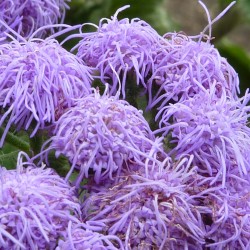Menu
-
MenuTerug
- Home
-
Categorieën
-
-
Categorieën
-
Groentezaden
-
Rassen per land
- Soorten uit Armenië
- Rassen uit BiH
- Rassen uit Kroatië
- Rassen uit Frankrijk
- Varieties from Germany
- Varieties from Greece
- Varieties from Hungary
- Rassen uit India
- Varieties from Italy
- Rassen uit Japan
- Rassen uit Noord-Macedonië
- Varieties from Peru
- Varieties from Russia
- Varieties from Serbia
- Rassen uit Slovenië
- Varieties from Spain
- Varieties from Thailand
- Rassen uit Turkije
- Varieties from USA
- Tomatenzaden
- Maïs zaden
- Kalebas familie
- Bean familie
- Komkommerzaden
- Paprika Zaden
- Wortelfamilie
- Ui familie
- Sla zaden
- Aardappelfamilie
- Kool familie
- Radijs zaden
- Rode biet familie
- Watermeloen zaden
- Meloenzaden
- Bloemkoolzaden
- Zonnebloem familie
-
Rassen per land
- Fruit zaden
- Chili zaden
- Medicinale kruidenzaden
- Klimplanten Zaden
- Bomen - Struik - Zaden
- Palmzaden
- Siergrassenzaden
- Tabakszaden
-
Groentezaden
-
-
-
-
- NIEUWE PRODUCTEN
- Account aanmaken
- Levering - Betaling
- FAQ
- Home
-
- Grote pakjes zaden
- Gigantische plantenzaden
- Groentezaden
- Rassen per land
- Soorten uit Armenië
- Rassen uit BiH
- Rassen uit Kroatië
- Rassen uit Frankrijk
- Varieties from Germany
- Varieties from Greece
- Varieties from Hungary
- Rassen uit India
- Varieties from Italy
- Rassen uit Japan
- Rassen uit Noord-Macedonië
- Varieties from Peru
- Varieties from Russia
- Varieties from Serbia
- Rassen uit Slovenië
- Varieties from Spain
- Varieties from Thailand
- Rassen uit Turkije
- Varieties from USA
- Tomatenzaden
- Maïs zaden
- Kalebas familie
- Bean familie
- Komkommerzaden
- Paprika Zaden
- Wortelfamilie
- Ui familie
- Sla zaden
- Aardappelfamilie
- Kool familie
- Radijs zaden
- Rode biet familie
- Watermeloen zaden
- Meloenzaden
- Bloemkoolzaden
- Zonnebloem familie
- Rassen per land
- Fruit zaden
- Chili zaden
- Medicinale kruidenzaden
- Klimplanten Zaden
- Bomen - Struik - Zaden
- Banaan zaden
- Palmzaden
- Siergrassenzaden
- Tabakszaden
- Bloemzaadjes
- Cactus zaden
- Waterplanten zaden
- Instructies voor het zaaien
- Fruit- en groentevormen
- Paddestoel Mycelium
- Plant knollen
- Bamboe zaden
- Ayurvedische planten
- F1 hybride zaden
- Verpakkingen en zo
- Koud-resistente planten
- Planten zorg
- Biologische specerijen
- Levering - Betaling
- Geen PayPal- en kaartbetaling X
Laatste product reviews
Out of the two seeds, one germinated and the other one was dead and floatin...
Door
 Riikka H op 07/03/2024
Riikka H op 07/03/2024
geverifieerde koper
Best verkochte producten
Er zijn 1294 producten.
Item 886-900 van 1294 in totaal item(s)
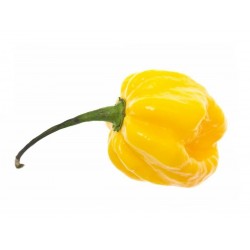
Scotch Bonnet Yellow Chili...
Prijs
€ 2,00
(SKU: C 89 Y)
Seeds Gallery EU,
5/
5
<div id="idTab1" class="rte">
<h2><span style="text-decoration:underline;"><em><strong>Scotch Bonnet Yellow Seeds</strong></em></span></h2>
<h3><span style="color:#ff0000;"><strong>Price for Package of 5 seeds.</strong></span></h3>
<div>Scotch bonnet is one of the most popular chilli peppers. This variety matures from green to yellow. The plant grows up to 1 metre tall and produces lots of fruits, 4-6cm long. Long growing season, most suitable for greenhouse production, february sowing.</div>
<div>Cultivation: Sow early December-January Under glass, or for maincrop March - April. Spacing 30-60cm x 45-90cm. The seeds germinate between 25 and 30°C. Grow on at 16-23°C. The seeds require good ventilation so do not further cover the seeds in bags/propagators unless absolutely necessary. </div>
<div>Harvest from early April/May, or maincrop from July.</div>
<div>Only water when the soil around the roots is dry as overwatering can produce a smaller crop of more sour tasting fruits. A ph level in the growing media that is slightly acidic is useful. </div>
<div>The seeds do not need sunlight to germinate, but once they sprout you need to place them under fluorescent lights for 10 to 16 hours per day. You can reduce the temperature to 70 degrees after they sprout. </div>
<div>A liquid feed with a good quality Tomato feed will be envigorate the plants once they are established but do not overwater/feed.</div>
<div>This variety may grow outdoors but they are best used as a greenhouse crop or perhaps on a nice sunny windowledge!</div>
</div>
C 89 Y

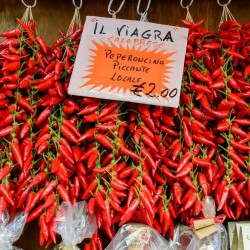
Italian PEPERONCINI Hot...
Prijs
€ 1,85
(SKU: C 67)
Seeds Gallery EU,
5/
5
<h2><strong>Italian PEPERONCINI Hot Chili Seeds</strong></h2>
<h2><span style="color:#ff0000;"><strong>Price for Package of 10 seeds.</strong></span></h2>
<p>The famous Italian hot Chili. Although it is an old Italian variety, it is now generally found only in the southern part of Italy. The plants grow up to some 40-50 centimeters in height and give truly plentiful fruits that grow upwards and are very hot.</p>
<p>The fruits are about 3 cm long and change color from green to red when ripe. We personally brought this Chili from Italy whose fruits we naturally dried in the sun and we can tell you that this variety is great for drying and grinding. Otherwise, given that the plant is small compact, this Chili is also great for growing in pots.</p>
<p>If you bring the pot inside the house before winter - next year you will already have the ripe fruits of this excellent and hot Chili in May ...</p>
C 67


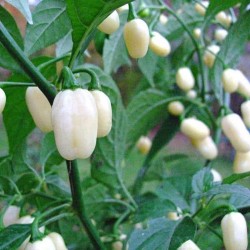
Habanero White Seeds
Prijs
€ 1,85
(SKU: C 10 W)
Seeds Gallery EU,
5/
5
<h2><span style="text-decoration:underline;"><em><strong>Habanero White Seeds</strong></em></span></h2>
<h3><span style="color:#ff0000;"><strong>Price for Package of 3 seeds.</strong></span></h3>
<div>The White Habanero also known as 'Peruvian White Habanero' is a lovely and rare variety that is hard to come by and said to originate from Peru. <span style="font-size:11px;line-height:1.5em;">These fiery hot jelly bean shaped peppers grow on small, but very high yielding bushy pepper plants with the creamy-white coloured pods measuring 5cm (2in) long by 2cm (¾in) in diameter. </span></div>
<div> </div>
<div>If you like searing hot chillies, this could be the one for you as they have been rated at over 300,000 Scoville heat units. These awesomely hot chillies have a distinctive smoky flavour and the creamy-white fruits make for striking plants. </div>
<div>The plant grows to around 45cm tall (18in). They will grow happily outside over the summer in pots, or planted into the garden, but bring them in before the first frosts to prolong fruiting. </div>
<div>Maturing in around 90 days, this is a rare and unusual chilli for your collection.</div>
<div> </div>
<div> </div>
<div>Storage of Seeds: </div>
<div>Store seeds away from children, sealed in their packaging in a cool, dry, dark place, or in a fridge. Never store them in a freezer as the sudden temperature drop is likely to kill them. Don't leave the seeds in direct sunlight as the heat generated may kill them.</div>
<div> </div>
<div>Sowing: Sow from mid February to mid June</div>
<div>The temperature, moisture, and air circulation all play a role in growing plants from seeds. Too little heat, too much moisture, and lack of air circulation will cause poor results. Do not use jiffy peat pots, plugs, or potting soil as the soil becomes too dry or too wet, which can lead to low germination, disease and fungus.</div>
<div> </div>
<div>Fill small cells or trays with a good sterile seed compost and sow the seeds on the surface. “Just cover” with a fine sprinkling (3mm) of soil or vermiculite.</div>
<div>Keep the compost moist - don't let the top of the compost dry out (a common cause of germination failure) If you wish, spray the surface with a dilute copper-based fungicide.</div>
<div>Cover the pot or tray with plastic film or place in a heated propagator, south facing window or a warm greenhouse. </div>
<div>The ideal temperature is around 18 to 20°C (65 to 72°F)</div>
<div> </div>
<div>Transplanting: </div>
<div>When the seedlings have produced their first pair of true leaves they can be potted on into individual 7 to 10cm (3 to 4in) pots. Use good quality potting compost and mix in some organic slow release fertiliser. Pot the chilli on again before it becomes root-bound.</div>
<div>Water the seedlings regularly, but don't let them become waterlogged as this encourages rot. Don't let them dry out as they rarely recover at this stage. Water the soil, not the foliage. Once the plants have established, it is better to water heavy and infrequently, allow the top inch or so to dry out in between watering.</div>
<div> </div>
<div>Seedlings should be grown in good light, but should not be exposed to direct sunlight from late spring to early autumn. Weaker sunlight from autumn to spring is unlikely to do them harm. Once seedlings have put on some growth they need lots of light. Growing them under a grow-light produces excellent stocky plants, as will a warm sunny windowsill. Adult chilli plants need lots of light. However, more than 4 hours or so in hot direct sunlight will dry them out quickly.</div>
<div>Acclimatise to outdoor conditions for 2 to 3 weeks before they are moved permanently outside. Plant them into rich moist soil. Flower do not form and fruit will not set if the temperature is much below 17°C (62°F) for most of the day, so wait until June/July for best results with outdoor planting.</div>
<div> </div>
<div>Fertilising: </div>
<div>After the first flowers appear, feed every 1 or 2 weeks with a half-strength liquid tomato feed. You could also add Seaweed extract to the water once a week.</div>
<div> </div>
<div>Pollinating Flowers: (optional)</div>
<div>Chilli plants are self fertile and will generally pollinate themselves. However, if you want to give them a helping hand to ensure that lots of fruit are set indoors, use a cotton wool bud to gently sweep the inside of the flowers, spreading the pollen as you go. The flower's petals will drop off as the green middle part of the flower starts to swell slightly. This is the chilli pepper beginning to grow.</div>
<div> </div>
<div>Harvesting: Harvest in approx 90 days</div>
<div>Harvest any time after they are fully developed but the longer you leave them on the hotter they will become. Harvest peppers as they mature to encourage new buds to form. Use scissors so you don't damage the plant.</div>
<div> </div>
<div>Storage: </div>
<div>After picking eat fresh or dry the peppers by putting them into a mesh bag, hang the bag up in a dry, airy, but not sunny spot. When they are completely dry, you can make paprika by grinding the peppers. Don't grind the stalks. You can regulate the spiciness of the result by including more or less of the seeds and veins.</div>
<div> </div>
<div>WARNING: </div>
<div>Be careful handling chilli seeds as they can cause a painful burning sensation: Avoid contact with the eyes or any sensitive skin before washing your hands thoroughly.</div>
<p>These peppers are very hot please make sure whomever tries them knows before-hand !</p>
<table class="data-table" cellspacing="0"><tbody><tr class="first odd"><td class="label"><strong><span style="color:#008000;">Packet Size</span></strong></td>
<td class="data last"><span style="color:#008000;">3 Seeds</span></td>
</tr><tr class="even"><td class="label"><strong><span style="color:#008000;">Common Name</span></strong></td>
<td class="data last"><span style="color:#008000;">Peruvian White Habanero </span><br /><span style="color:#008000;">Very Hot, over 300,000 Scoville units</span></td>
</tr><tr class="odd"><td class="label"><strong><span style="color:#008000;">Other Common Names</span></strong></td>
<td class="data last"><span style="color:#008000;">Chili, Chile or Chilli. Hot Peppers.</span></td>
</tr><tr class="even"><td class="label"><strong><span style="color:#008000;">Family</span></strong></td>
<td class="data last"><span style="color:#008000;">Solanaceae</span></td>
</tr><tr class="odd"><td class="label"><strong><span style="color:#008000;">Genus</span></strong></td>
<td class="data last"><span style="color:#008000;">Capsicum</span></td>
</tr><tr class="even"><td class="label"><strong><span style="color:#008000;">Species</span></strong></td>
<td class="data last"><span style="color:#008000;">chinense</span></td>
</tr><tr class="odd"><td class="label"><strong><span style="color:#008000;">Cultivar</span></strong></td>
<td class="data last"><span style="color:#008000;">White Habanero</span></td>
</tr><tr class="even"><td class="label"><strong><span style="color:#008000;">Synonym</span></strong></td>
<td class="data last"><span style="color:#008000;">Peruvian or Yucatan White Habanero</span></td>
</tr><tr class="odd"><td class="label"><strong><span style="color:#008000;">Hardiness</span></strong></td>
<td class="data last"><span style="color:#008000;">Tender Perennial</span></td>
</tr><tr class="even"><td class="label"><strong><span style="color:#008000;">Height</span></strong></td>
<td class="data last"><span style="color:#008000;">Grows to around 45cm (18 in) tall</span></td>
</tr><tr class="odd"><td class="label"><strong><span style="color:#008000;">Position</span></strong></td>
<td class="data last"><span style="color:#008000;">Grown in good light, but should not be exposed to direct sunlight</span></td>
</tr><tr class="even"><td class="label"><strong><span style="color:#008000;">Soil</span></strong></td>
<td class="data last"><span style="color:#008000;">Rich moist soil.</span></td>
</tr><tr class="odd"><td class="label"><strong><span style="color:#008000;">Time to Sow</span></strong></td>
<td class="data last"><span style="color:#008000;">Sow from mid February to mid June</span></td>
</tr><tr class="even"><td class="label"><strong><span style="color:#008000;">Harvest</span></strong></td>
<td class="data last"><span style="color:#008000;">The longer you leave them on the hotter they will become</span></td>
</tr><tr class="last odd"><td class="label"><strong><span style="color:#008000;">Time to Harvest</span></strong></td>
<td class="data last"><span style="color:#008000;">90 days</span></td>
</tr></tbody></table>
C 10 W

- Alleen online
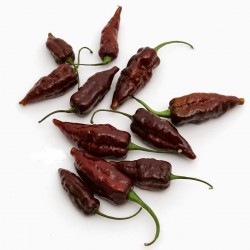
Fatalii Choco Chili Seeds
Prijs
€ 2,50
(SKU: C 29 C)
Seeds Gallery EU,
5/
5
<h2><span style="text-decoration: underline;" class=""><em><strong>Fatalii Choco Chili Seeds</strong></em></span></h2>
<h3><span style="color: #ff0000;"><strong>Price for Package of 5 seeds.<br></strong></span></h3>
<div>The Fatalii is a chili pepper of Capsicum chinense that originates in central and southern Africa. It is described to have a fruity, citrus flavor with a searing heat that is comparable to the standard habanero. The Scoville Food Institute lists the Fatalii as the sixth hottest pepper with Scoville units ranging from 125,000 ~ 325,000 units.</div>
<div><strong>Cultivation</strong></div>
<div>The plants grow 20 to 25 inches in height, and plant distance should be about the same. The pendant pods get 2.5 to 3.5 inches long and about 0.75 to 1.5 inches wide. From a pale green, they mature to a bright yellow (there are red Fataliis around as well, but the yellow one is the "real thing.")</div>
<div><strong>Culinary Use</strong></div>
<div>The Fatalii is known for its extreme heat and citrus flavor. As such, it makes for a unique hot sauce that usually comprises other citrus flavors (e.g., lime, lemon). The walls of the peppers are very thin, making it very easy to dry. After drying, the peppers can be used as powders.</div><script src="//cdn.public.n1ed.com/G3OMDFLT/widgets.js"></script>
C 29 C


Plant bestand tegen kou en vorst
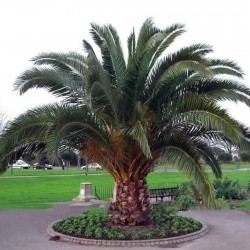
Zaden Canarische dadelpalm...
Prijs
€ 2,75
(SKU: PS 5)
Seeds Gallery EU,
5/
5
<h2 id="short_description_content"><strong>Zaden Canarische dadelpalm (Phoenix canariensis)</strong></h2>
<h2><span style="color: #ff0000;"><strong>Prijs voor pakket met 10, 50 zaden.</strong></span></h2>
<p>De<span> </span><b>Canarische dadelpalm</b><span> </span>(<i>Phoenix canariensis</i>) is een tot 18 m hoge,<span> </span>tweehuizige<span> </span>palm<span> </span>met een gedrongen stam met bladlittekens en een dichte kroon met vijftig tot honderd geveerde<span> </span>bladeren. De bladeren zijn 5-6 m lang, breed, kort gesteeld en gebogen overhangend. De deelblaadjes zijn groen, stevig, smal-lancetvormig en V-vormig gevouwen. De onderste deelblaadjes zijn vaak gereduceerd en gedoornd. De middelste deelblaadjes zijn 40-50 cm lang.</p>
<p>De palm bloeit van februari tot juni. Jonge<span> </span>bloeiwijzen<span> </span>worden door een<span> </span>schutblad<span> </span>omgeven. De<span> </span>bloemetjes<span> </span>zijn crèmekleurig tot geel. De mannelijke bloemen staan dicht opeen in de as van de mannelijke bloeiwijze. De vrouwelijke bloeiwijzen zijn sterk vertakt en verkleuren tijdens de bloei van lichtgeel tot oranjerood. De talrijke<span> </span>vruchten<span> </span>staan dicht opeen in vertakte trossen. Ze zijn langwerpig-eivormig, 1,5-2,3 cm lang, weinig vlezig en rijpen van oranje naar donker roodbruin. In tegenstelling tot de vruchten van de echte<span> </span>dadelpalm<span> </span>(<i>Phoenix dactylifera</i>) zijn ze oneetbaar.</p>
<p>De Canarische dadelpalm is<span> </span>endemisch<span> </span>op de<span> </span>Canarische Eilanden. Palmen in hun natuurlijke leefgebied zijn zeldzaam geworden. De plant groeit sneller en is minder koudegevoelig dan de echte dadelpalm en wordt daarom in het hele<span> </span>Middellandse Zeegebied<span> </span>vaak als sierplant aangeplant.</p>
<p></p><script src="//cdn.public.n1ed.com/G3OMDFLT/widgets.js"></script>
PS 5 (10 S)


Plant bestand tegen kou en vorst
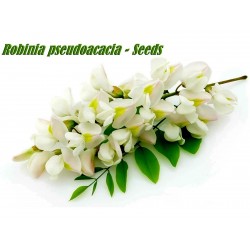
White Wisteria Seeds...
Prijs
€ 2,00
(SKU: T 45)
Seeds Gallery EU,
5/
5
<div id="idTab1" class="rte">
<h2><span style="font-size: 14pt;"><strong>White Wisteria Seeds (Robinia pseudoacacia)</strong></span></h2>
<h2><span style="color: #ff0000; font-size: 14pt;"><strong>Price for Package of 20 seeds.</strong></span></h2>
<p>Robinia pseudoacacia, commonly known as the White Wisteria, is a tree of the genus Robinia in the subfamily Faboideae of the pea family Fabaceae. It is native to the southeastern United States, but has been widely planted and naturalized elsewhere in temperate North America, Europe, Southern Africa and Asia and is considered an invasive species in some areas. A less frequently used common name is false Acacia, which is a literal translation of the specific epithet. It was introduced into Britain in 1636.</p>
<p><strong>Description</strong></p>
<p>With a trunk up to 0.8 m diameter (exceptionally up to 52 m tall[2] and 1.6 m diameter in very old trees), with thick, deeply furrowed blackish bark. The leaves are 10–25 cm long, pinnate with 9–19 oval leaflets, 2–5 cm long and 1.5–3 cm broad. Each leaf usually has a pair of short spines at the base, 1–2 mm long or absent on adult crown shoots, up to 2 cm long on vigorous young plants. The intensely fragrant (reminiscent of orange blossoms) flowers are white to lavender or purple, borne in pendulous racemes 8–20 cm long, and are edible. The fruit is a legume 5–10 cm long, containing 4–10 seeds.</p>
<p>Although similar in general appearance to the honey locust, it lacks that tree’s characteristic long branched thorns on the trunk, instead having the pairs of short spines at the base of each leaf; the leaflets are also much broader.</p>
<p>The black locust is native in the United States from Pennsylvania to northern Georgia and westward as far as Arkansas and Oklahoma, but has been widely spread. The tree reaches a height of seventy feet, with a trunk three or four feet in diameter and brittle branches that form an oblong narrow head. It spreads by underground shoots. The leaflets fold together in wet weather and at night; some change of position at night is a habit of the entire leguminous family.</p>
<p>Bark: Dark gray brown tinged with red, deeply furrowed, surface inclined to scale. Branchlets at first coated with white silvery down. This soon disappears and they become pale green, afterward reddish brown. Prickles develop from stipules, are short, somewhat triangular, dilated at base, sharp, dark purple, adhering only to the bark, but persistent.</p>
<p><strong>Wood</strong>: Pale yellowish brown; heavy, hard, strong, close-grained and very durable in contact with the ground. The wood has a specific gravity 0.7333, and a weight of approximately 45.7 pounds per cubic foot</p>
<p><strong>Winter buds</strong>: Minute, naked, three or four together, protected in a depression by a scale-like covering lined on the inner surface with a thick coat of tomentum and opening in early spring; when forming are covered by the swollen base of the petiole.</p>
<p><strong>Leaves</strong>: Parallel, compound, odd-pinnate, 21-40 inches long, with slender hairy petioles, grooved and swollen at the base. Leaflets petiolate, seven to nine, one to two inches long, one-half to three-fourths of an inch broad, emarginate or rounded at apex. They come out of the bud conduplicate, yellow green, covered with silvery down which soon disappears; when full grown are dull dark green above, paler beneath. Feather-veined, midvein prominent. In autumn they turn a clear pale yellow. Leafs out relatively late in spring. Stipules linear, downy, membranous at first, ultimately developing into hard woody prickles, straight or slightly curved. Each leaflet has a minute stipel which quickly falls and a short petiole.</p>
<p><strong>Flowers</strong>: May or June, after the leaves. Papilionaceous. Perfect, borne in loose drooping racemes four to five inches long, cream-white, about an inch long, nectar bearing, fragrant. Pedicels slender, half an inch long, dark red or reddish green.</p>
<p><strong>Calyx</strong>: Campanulate, gibbous, hairy, five-toothed, slightly two-lipped, dark green blotched with red, especially on the upper side teeth valvate in bud.</p>
<p><strong>Corolla</strong>: Imperfectly papilionaceous, petals inserted upon a tubular disk; standard white with pale yellow blotch; wings white, oblong-falcate; keel petals incurved, obtuse, united below.</p>
<p><strong>Stamens</strong>: Ten, inserted, with the petals, diadelphous, nine inferior, united into a tube which is cleft on the upper side, superior one free at the base. Anthers two-celled, cells opening longitudinally.</p>
<p><strong>Pistil</strong>: Ovary superior, linear-oblong, stipitate, one-celled; style inflexed, long, slender, bearded; stigma capitate; ovules several, two-ranked.</p>
<p><strong>Fruit</strong>: legume two-valved, smooth three to four inches long and half an inch broad, usually four to eight seeded. Ripens late in autumn and hangs on the branches until early spring. Seeds dark orange brown with irregular markings. Cotyledons oval, fleshy.</p>
<p><strong>Cultivation</strong></p>
<p>Black locust is a major honey plant in the eastern US, and, having been taken and planted in France, Italy and other European nations. At least In France and Italy it is the source of the renowned acacia monofloral honey. Flowering starts after 140 growing degree days. However, its blooming period is short (about 10 days) and it does not consistently produce a honey crop year after year. Weather conditions can have quite an effect on the amount of nectar collected as well; in Ohio state for example, good locust honey flow happens in one out of five years.</p>
<p>In Europe it is often planted alongside streets and in parks, especially in large cities, because it tolerates pollution well. The species is unsuitable for small gardens due to its large size and rapid growth, but the cultivar ‘Frisia’, a selection with bright yellow-green leaves, is occasionally planted as an ornamental tree.</p>
<p>In South Africa it is regarded as a weed because of its habit of freely suckering from roots near the surface and aggravated by cutting of the main stem.</p>
<p>Black locust has nitrogen-fixing bacteria on its root system; for this reason it can grow on poor soils and is an early colonizer of disturbed areas.</p>
<p>In 1900 it was reported that the value of Robinia pseudoacacia was practically destroyed in nearly all parts of the United States beyond the mountain forests which are its home by locust borers which riddle the trunk and branches. Were it not for these insects, it would be one of the most valuable timber trees that could be planted in the northern and middle states. Young trees grow quickly and vigorously for a number of years, but soon become stunted and diseased, and rarely live long enough to attain any commercial value.</p>
<p><strong>Flavonoids content</strong></p>
<p>Black locust leaves contain flavone glycosides characterised by spectroscopic and chemical methods as the 7-O-β-d-glucuronopyranosyl-(1 → 2)[α-l-rhamnopyranosyl-(1 → 6)]-β-d-glucopyranosides of acacetin (5,7-dihydroxy-4′-methoxyflavone), apigenin (5,7,4′-trihydroxyflavone), diosmetin (5,7,3′-trihydroxy-4′-methoxyflavone) and luteolin (5,7,3′,4′-tetrahydroxyflavone).</p>
<p><strong>Uses</strong></p>
<p>The wood is extremely hard, resistant to rot and durable, making it prized for furniture, flooring, paneling, fence posts and small watercraft. Wet, newly-cut planks have an offensive odour which disappears with seasoning. As a young man, Abraham Lincoln spent much of his time splitting rails and fence posts from black locust logs. Black locust is still in use in rustic handrail systems. Flavonoids in the heartwood allow the wood to last over 100 years in soil.[7] In the Netherlands and some other parts of Europe, black locust is one of the most rot-resistant local trees, and projects have started to limit the use of tropical wood by promoting this tree and creating plantations. It is one of the heaviest and hardest woods in North America.</p>
<p>Black locust is highly valued as firewood for wood-burning stoves; it burns slowly, with little visible flame or smoke, and has a higher heat content than any other species that grows widely in the Eastern United States, comparable to the heat content of anthracite.[8] It is most easily ignited by insertion into a hot stove with an established coal bed.[citation needed] For best results it should be seasoned like any other hardwood, however black locust is also popular because of its ability to burn even when wet.[9] In fireplaces it can be less satisfactory because knots and beetle damage make the wood prone “spitting” coals for distances of up to several feet.[citation needed] If the black locust is cut, split, and cured while relatively young (within ten years), thus minimizing beetle damage, “spitting” problems are minimal.</p>
<p>It is also planted for firewood because it grows rapidly, is highly resilient in a variety of soils, and it grows back even faster from its stump after harvest by using the existing root system.</p>
<p>With fertilizer prices rising, the importance of black locust as a nitrogen-fixing species is also noteworthy. The mass application of fertilizers in agriculture and forestry is increasingly expensive; therefore nitrogen-fixing tree and shrub species are gaining importance in managed forestry.</p>
<p>In traditional medicine of India different parts of Robinia pseudoacacia are used as laxative, antispasmodic, and diuretic.</p>
<p><strong>Toxicity</strong></p>
<p>Black locust’s pods are small and light, and easily carried long distances. Although the bark and leaves are toxic, various reports suggest that the seeds and the young pods of the black locust are edible. Shelled seeds are safe to harvest from summer through fall, and are edible both raw and/or boiled.[12] Due to the small nature of Black Locust seeds, shelling them efficiently can prove tedious and difficult. In France and in Italy Robinia pseudoacacia flowers are eaten as beignets after being coated in batter and fried in oil. [13] Important constituents of the plant are the toxalbumin robin, which loses its toxicity when heated and robinin, a non-toxic glucoside.[14] Horses that consume the plant show signs of anorexia, depression, incontinence, colic, weakness, and cardiac arrhythmia. Symptoms usually occur about 1 hour following consumption, and immediate veterinary attention is required.</p>
<p><strong>History</strong></p>
<p>The name locust is said to have been given to Robinia by Jesuit missionaries, who fancied that this was the tree that supported St. John in the wilderness, but it is native only to North America. The locust tree of Spain (Ceratonia siliqua or Carob Tree), which is also native to Syria and the entire Mediterranean basin, is supposed to be the true locust of the New Testament.</p>
<p>Robinia is now a North American genus, but traces of it are found in the Eocene and Miocene rocks of Europe.</p>
</div>
T 45 (20 S)

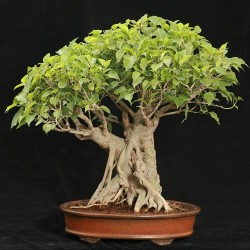
Sacred Fig Seeds (Ficus...
Prijs
€ 2,45
(SKU: T 34)
Seeds Gallery EU,
5/
5
<h2><strong>Sacred Fig Seeds (Ficus religiosa)</strong></h2>
<h2><span style="color:#ff0000;"><strong>Price for Package of 20 seeds.</strong></span></h2>
<div>Ficus religiosa or Sacred Fig is species of fig native to India, Bangladesh, Nepal, Pakistan, Sri Lanka, southwest China and Indochina. It belongs to the Moraceae, the fig or mulberry family. It is also known as Bo-Tree (from the Sanskrit Bodhi: "wisdom", "enlightened", and as a Sinhalization of this the Sinhala Bo) or [1] Peepal (in India),.</div>
<div>Ficus religiosa is a large dry season-deciduous or semi-evergreen tree up to 30 metres (98 ft) tall and with a trunk diameter of up to 3 metres (9.8 ft). The leaves are cordate in shape with a distinctive extended tip; they are 10–17 cm long and 8–12 cm broad, with a 6–10 cm petiole. The fruit is a small fig 1-1.5 cm diameter, green ripening to purple.</div>
<div>Buddhist legend tells of Gautama Buddha attained enlightenment (bodhi) while meditating underneath the Bodhi tree, a Ficus religiosa. The site is in present day Bodh Gaya, northern India. The Bodhi tree and the Sri Maha Bodhi propagated from it are notable specimens of Sacred Fig. The known planting date of the latter, 288 BCE, gives it the oldest verified age for any flowering plant (angiosperm).</div>
<div>In Theravada Buddhist Southeast Asia, the tree's massive trunk is often the site of Buddhist or animist shrines.</div>
<div>Not all Ficus religiosa can be called a 'Bodhi tree'. A 'Bodhi tree' must be able to trace its parent to another Bodhi tree and the line goes on until the first Bodhi tree under which the Lord Gautama Buddha gained enlightenment.</div>
<div>Sadhus (Hindu ascetics) still meditate beneath sacred fig trees, and Hindus do pradakshina (circumambulation) around the sacred fig tree as a mark of worship. Usually seven pradakshinas are done around the tree in the morning time chanting "Vriksha Rajaya Namah", meaning "salutation to the king of trees."</div>
<div>Plaksa is a possible Sanskrit term for Ficus religiosa. However, according to Macdonell and Keith (1912), it denotes the Wavy-leaved Fig tree (Ficus infectoria) instead.</div>
<div>In Hindu texts, the Plaksa tree is associated with the source of the Sarasvati River. The Skanda Purana states that the Sarasvati originates from the water pot of Brahma and flows from Plaksa on the Himalayas. According to Vamana Purana 32.1-4, the Sarasvati was rising from the Plaksa tree (Pipal tree).</div>
<div>Plaksa Pra-sravana denotes the place where the Sarasvati appears.[5] In the Rigveda Sutras, Plaksa Pra-sravana refers to the source of the Sarasvati.</div>
<p>Ficus religiosa is used in traditional medicine for about 50 types of disorders including asthma, diabetes, diarrhea, epilepsy, gastric problems, inflammatory disorders, infectious and sexual disorders.</p>
<table cellspacing="0" cellpadding="0" border="1"><tbody><tr><td colspan="2" width="100%" valign="top">
<h3 align="center"><span style="color:#008000;"><strong>Sowing Instructions</strong></span></h3>
</td>
</tr><tr><td valign="top" nowrap="nowrap">
<p align="center"><span style="color:#008000;"><strong>Propagation:</strong></span></p>
</td>
<td valign="top">
<p align="center"><span style="color:#008000;">Seeds</span></p>
</td>
</tr><tr><td valign="top" nowrap="nowrap">
<p align="center"><span style="color:#008000;"><strong>Pretreat:</strong></span></p>
</td>
<td valign="top">
<p align="center"><span style="color:#008000;">0</span></p>
</td>
</tr><tr><td valign="top" nowrap="nowrap">
<p align="center"><span style="color:#008000;"><strong>Stratification:</strong></span></p>
</td>
<td valign="top">
<p align="center"><span style="color:#008000;">0</span></p>
</td>
</tr><tr><td valign="top" nowrap="nowrap">
<p align="center"><span style="color:#008000;"><strong>Sowing Time:</strong></span></p>
</td>
<td valign="top">
<p align="center"><span style="color:#008000;">all year round</span></p>
</td>
</tr><tr><td valign="top" nowrap="nowrap">
<p align="center"><span style="color:#008000;"><strong>Sowing Depth:</strong></span></p>
</td>
<td valign="top">
<p><span style="color:#008000;">Needs Light to germinate!</span></p>
<p><span style="color:#008000;">Just sprinkle on the surface of the substrate + gently press</span></p>
</td>
</tr><tr><td valign="top" nowrap="nowrap">
<p align="center"><span style="color:#008000;"><strong>Sowing Mix:</strong></span></p>
</td>
<td valign="top">
<p align="center"><span style="color:#008000;">Coir or sowing mix + sand or perlite</span></p>
</td>
</tr><tr><td valign="top" nowrap="nowrap">
<p align="center"><span style="color:#008000;"><strong>Germination temperature:</strong></span></p>
</td>
<td valign="top">
<p align="center"><span style="color:#008000;">25-27°C</span></p>
</td>
</tr><tr><td valign="top" nowrap="nowrap">
<p align="center"><span style="color:#008000;"><strong>Location:</strong></span></p>
</td>
<td valign="top">
<p align="center"><span style="color:#008000;">bright + keep constantly moist not wet</span></p>
</td>
</tr><tr><td valign="top" nowrap="nowrap">
<p align="center"><span style="color:#008000;"><strong>Germination Time:</strong></span></p>
</td>
<td valign="top">
<p align="center"><span style="color:#008000;">3 - 6 weeks</span></p>
</td>
</tr><tr><td valign="top" nowrap="nowrap">
<p align="center"><span style="color:#008000;"><strong>Watering:</strong></span></p>
</td>
<td valign="top">
<p align="center"><span style="color:#008000;">Water regularly during the growing season</span></p>
</td>
</tr><tr><td valign="top" nowrap="nowrap"><span style="color:#008000;"> </span></td>
<td valign="top">
<p align="center"><br /><span style="color:#008000;"><em>Copyright © 2012 Seeds Gallery - Saatgut Galerie - Galerija semena. </em><em>All Rights Reserved.</em></span></p>
</td>
</tr></tbody></table>
T 34

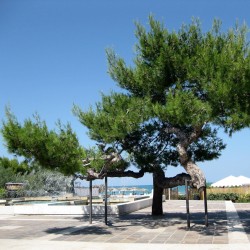
Jerusalem Pine Seeds
Prijs
€ 1,75
(SKU: T 28)
Seeds Gallery EU,
5/
5
<div id="idTab1" class="rte">
<h2><span style="font-size:14pt;"><strong>Jerusalem Pine Seeds (Pinus Halepensis)</strong></span></h2>
<h2><span style="color:#ff0000;font-size:14pt;"><strong>Price for Package of 5 seeds.</strong></span></h2>
<p>The Aleppo Pine tree is a Maltese indigenous tree and grows in most Mediterranean countries. It is a coniferous, evergreen tree. It is a small to medium-sized tree, reaching 15-25m of length and with a trunk diameter of up to 60cm. The leaves are very slender like ‘needles’ and are 6-12cm long, light green in colour and produced in pairs. The cones are 5-8cm long and 2-3cm broad at the base when closed, green at first, ripening to brown when 24 months old. They open slowly over the next few years, a process quickened if they are exposed to heat such as in forest fires. The cones open wide to allow the seeds to disperse. The seeds are 5-6mm long, with a 20mm wing, and are wind-dispersed. Aleppo pine reproduces by seed only. Seeds are mostly shed during summer. Up to 90% of seeds can germinate. The tree starts producing after its fourth year.</p>
<p>There are no male or female Aleppo Pine trees, but the tree produces male and female cones which start growing in autumn. Female cones are usually closer to the top and grow as individuals. Male cones grow in clusters. The one that we normally think of as a ‘cone’ is the female cone that produces the seeds. Since the male cones are full of pollen which is dispersed by the slightest movement, female cones are wind pollinated.</p>
<p>When one of the branches of the Aleppo Pine tree is cut off, the tree will never again grow another branch from the same place but will remain without that branch for the rest of its life. When a branch is cut off, a sticky substance called „resin‟ comes out from the tree trunk. This is a natural disinfectant which the tree produces to disinfect its wound. In colder countries, where a similar species of pine is cut down to produce timber and paper, this resin is collected and used in pine disinfectant.</p>
</div>
T 28

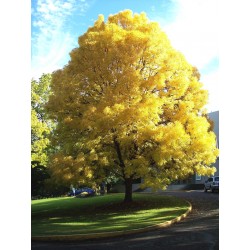
European ash Seeds
Prijs
€ 1,50
(SKU: T 22)
Seeds Gallery EU,
5/
5
<!DOCTYPE html>
<html>
<head>
<meta http-equiv="Content-Type" content="text/html; charset=UTF-8" />
</head>
<body>
<h2><span style="font-size: 14pt;"><strong>European ash Seeds (Fraxinus excelsior)</strong></span></h2>
<h2><span style="color: #ff0000;"><strong><span style="font-size: 14pt;">Price for Package of 20 seeds.</span></strong></span></h2>
<div>Fraxinus excelsior — known as the ash, or European ash or common ash to distinguish it from other types of ash — is a species of Fraxinus native to most of Europe with the exception of northern Scandinavia and southern Iberia, and also southwestern Asia from northern Turkey east to the Caucasus and Alborz mountains. The northernmost location is in the Trondheimsfjord region of Norway. it is a large deciduous tree growing to 20–35 m (exceptionally to 46 m) tall with a trunk up to 2 m (exceptionally to 3.5 m) diameter, with a tall, domed crown. The bark is smooth and pale grey on young trees, becoming thick and vertically fissured on old trees. The shoots are stout, greenish-grey, with jet black buds (which distinguish it from most other ash species, which have grey or brown buds). The leaves are 20–35 cm long, pinnate compound, with 7-13 leaflets, the leaflets 3–12 cm long and 0.8–3 cm broad, sessile on the leaf rachis, and with a serrated margin. The leaves are often among the last to open in spring, and the first to fall in autumn if an early frost strikes; they have no marked autumn colour, often falling dull green. The flowers open before the leaves, the female flowers being somewhat longer than the male flowers; they are dark purple, and without petals, and are wind-pollinated. Both male and female flowers can occur on the same tree, but it is more common to find all male and all female trees; a tree that is all male one year can produce female flowers the next, and similarly a female tree can become male. The fruit is a samara 2.5-4.5 cm long and 5–8 mm broad, often hanging in bunches through the winter; they are often called 'ash keys'.[1][3][4] If the fruit is gathered and planted when it is still green and not fully ripe, it will germinate straightaway, however once the fruit is brown and fully ripe, it will not germinate until 18 months after sowing (i.e. not until two winters have passed).</div>
<div>European Ash rarely exceeds 250 years of age. However there are numerous ones estimated between 200 and 250 years old and there are a couple over 250. The largest is in Clapton Court, England and is 9 m (29 ft) in girth. There are several examples over 4.5 metres (15 feet) in Derbyshire alone.</div>
<div>Ecology</div>
<div>Ash occurs on a wide range of soil types, but is particularly associated with basic soils on calcareous substrates. The most northerly ashwood in Britain is on limestone at Rassal, Wester Ross, latitude 57.4278 N.</div>
<div>A number of Lepidoptera use the species as a food source. See Lepidoptera which feed on ashes.</div>
<div>Ash dieback</div>
<div>Ash dieback caused by the fungus Chalara fraxinea[6] has affected large numbers of trees since the mid-1990s, particularly in eastern and northern Europe (though the disease has been observed across much of its range).[7][8]</div>
<div>Uses</div>
<div>Replica of the body frame from the Volvo ÖV 4 car, made primarily from ash wood</div>
<div>The resilience and rapid growth made it an important resource for smallholders and farmers. It was probably the most versatile wood in the countryside with wide-ranging uses. Until World War II the trees were often coppiced on a ten year cycle to provide a sustainable source of timber for fuel and poles for building and woodworking.[9]</div>
<div>Wood</div>
<div>The colour of the wood ranges from creamy white through light brown, and the heart wood may be a darker olive-brown. Ash timber is hard, tough and very hard-wearing, with a coarse open grain and a density of 710 kg per cubic meter.[10] It lacks oak's natural resistance to decay, and is not as suitable for posts buried in the ground. Because of its high flexibility, shock-resistance and resistance to splitting. Ash wood is the traditional material for bows, tool handles, especially for hammers and axes, tennis rackets and snooker cue sticks[citation needed]and it was extensively used in the construction of early aircraft. Ash is valuable as firewood because it burns well even when 'green' (freshly cut).[11] Ash was coppiced, often in hedgerows, and evidence in the form of some huge boles with multiple trunks emerging at head height can still be seen in parts of Britain. In Northumberland, crab and lobster pots (traps) sometimes known as 'creeves' by local people are still made from ash sticks.[citation needed] Because of its elasticity European Ash wood was commonly used for walking sticks. Poles were cut from a coppice and the ends heated in steam. The wood could then be bent in a curved vise to form the handle of the walking stick. The light colour and attractive grain of ash wood make it popular in modern furniture such as chairs, dining tables, doors and other architectural features and wood flooring, although the wood is often popularly stained jet black.[citation needed]</div>
<p>Ash is the only wood used for the manufacture of hurleys, referred to as hurls in parts of Leinster and known as a camán in Irish, the timber sticks used in the game of hurling in Ireland. Hurleys are manufactured from the butt log (bottom 1.5 metre of the stem) and from trees ideally of a diameter at breast height of approximately 25-30 centimetres. Only fast grown, straight and branch free ash can be used for this purpose. Due to the lack of available ash in Ireland, over 75% of the timber needed to produce the 350,000 hurleys required for the game annually must be imported, mostly from eastern European countries.[12] The importance of ash timber to the game of hurling is reflected in the fact that the game is referred to all over Ireland as "The Clash Of The Ash".</p>
<table cellspacing="0" cellpadding="0" border="1">
<tbody>
<tr>
<td colspan="2" width="100%" valign="bottom">
<p align="center"><span style="color: #008000;"><strong>Sowing Instructions</strong></span></p>
</td>
</tr>
<tr>
<td width="35%" valign="bottom" nowrap="nowrap">
<p align="center"><span style="color: #008000;"><strong>Propagation:</strong></span></p>
</td>
<td width="64%" valign="bottom">
<p align="center"><span style="color: #008000;">Seeds </span></p>
</td>
</tr>
<tr>
<td width="35%" valign="bottom" nowrap="nowrap">
<p align="center"><span style="color: #008000;"><strong>Pretreat:</strong></span></p>
</td>
<td width="64%" valign="bottom">
<p align="center"><span style="color: #008000;">0</span></p>
</td>
</tr>
<tr>
<td width="35%" valign="bottom" nowrap="nowrap">
<p align="center"><span style="color: #008000;"><strong>Stratification:</strong></span></p>
</td>
<td width="64%" valign="bottom">
<p align="center"><span style="color: #008000;">0</span></p>
</td>
</tr>
<tr>
<td width="35%" valign="bottom" nowrap="nowrap">
<p align="center"><span style="color: #008000;"><strong>Sowing Time:</strong></span></p>
</td>
<td width="64%" valign="bottom">
<p align="center"><span style="color: #008000;">all year round</span></p>
</td>
</tr>
<tr>
<td width="35%" valign="bottom" nowrap="nowrap">
<p align="center"><span style="color: #008000;"><strong>Sowing Depth:</strong></span></p>
</td>
<td width="64%" valign="bottom">
<p align="center"><span style="color: #008000;">0.5 - 1 cm</span></p>
</td>
</tr>
<tr>
<td width="35%" valign="bottom" nowrap="nowrap">
<p align="center"><span style="color: #008000;"><strong>Sowing Mix:</strong></span></p>
</td>
<td width="64%" valign="bottom">
<p align="center"><span style="color: #008000;">Coir or sowing mix + sand or perlite</span></p>
</td>
</tr>
<tr>
<td width="35%" valign="bottom" nowrap="nowrap">
<p align="center"><span style="color: #008000;"><strong>Germination temperature:</strong></span></p>
</td>
<td width="64%" valign="bottom">
<p align="center"><span style="color: #008000;">about 20-25 ° C.</span></p>
</td>
</tr>
<tr>
<td width="35%" valign="bottom" nowrap="nowrap">
<p align="center"><span style="color: #008000;"><strong>Location:</strong></span></p>
</td>
<td width="64%" valign="bottom">
<p align="center"><span style="color: #008000;">bright + keep constantly moist not wet</span></p>
</td>
</tr>
<tr>
<td width="35%" valign="bottom" nowrap="nowrap">
<p align="center"><span style="color: #008000;"><strong>Germination Time:</strong></span></p>
</td>
<td width="64%" valign="bottom">
<p align="center"><span style="color: #008000;">3-5 weeks</span></p>
</td>
</tr>
<tr>
<td width="35%" valign="bottom" nowrap="nowrap">
<p align="center"><span style="color: #008000;"><strong>Watering:</strong></span></p>
</td>
<td width="64%" valign="bottom">
<p align="center"><span style="color: #008000;">Water regularly during the growing season</span></p>
</td>
</tr>
<tr>
<td width="35%" valign="bottom" nowrap="nowrap">
<p align="center"><span style="color: #008000;"><strong> </strong></span></p>
</td>
<td width="64%" valign="bottom">
<p align="center"><br /><span style="color: #008000;">Copyright © 2012 Seeds Gallery - Saatgut Galerie - Galerija semena. All Rights Reserved.</span></p>
</td>
</tr>
</tbody>
</table>
</body>
</html>
T 22


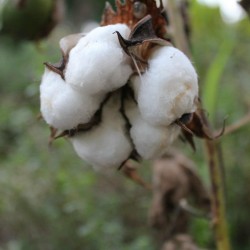
Cotton Seeds (Gossypium...
Prijs
€ 2,35
(SKU: T 10)
Seeds Gallery EU,
5/
5
<h2><strong>Cotton Seeds (Gossypium Herbaceum)</strong></h2>
<h2><span style="color: #ff0000;"><strong>Price for Package of 10 or 15 seeds.</strong></span></h2>
<p>Gossypium herbaceum is one of the cultivated cotton species. This short-lived and fast-growing perennial shrub can grow up to about 5 ft (1.5 m) tall. It has trilobed or palmate leaves and yellow hibiscus-like flowers. It produces capsules that split open when ripe and that display a loose tuft of white filaments, that constitute the cotton.</p>
<p>This plant likes a long, hot growing season to correctly grow and produce good fibers. Moreover, it is very cold tender and should be grown in frost-free climates. Elsewhere, it can be grown as an annual plant.</p>
<p><strong>WIKIPEDIA:</strong></p>
<p><i><b>Gossypium herbaceum</b></i>, commonly known as <b>Levant cotton</b>, <sup id="cite_ref-BSBI07_1-0" class="reference"></sup>is a species of cotton native to the semi-arid regions of sub-Saharan Africa and Arabia where it still grows in the wild as a perennial shrub.<span style="font-size: 11.6667px;"> </span>It is a sister-species of <i>Gossypium arboreum</i>.</p>
<h2><span class="mw-headline" id="Description">Description</span></h2>
<p><i>G. herbaceum</i><span> </span>has high<span> </span>stems<span> </span>that grow 2 feet (0.61 m) to 6 feet (1.8 m) high with wide, hairy leaves. Their<span> </span>flowers<span> </span>are small and yellow with a purple center. The plant exhibits<span> </span>extrafloral nectaries<span> </span>(calyculal nectaria, found on the receptacle, near the base of the<span> </span>calyculus).</p>
<p>When ripe and in warm weather, the flower capsule will burst and expose the cotton surrounding the<span> </span>seeds<span> </span>firmly. The cotton produced by this plant is short, about 2 inches (5.1 cm) long and is firmly attached to the seed, which is covered in hairy down. An<span> </span>acre<span> </span>of cotton can be expected to produce about 300 pounds (140 kg).</p>
<h2><span class="mw-headline" id="Uses">Uses</span></h2>
<p>Cotton fibers grow from the surface of the seeds and can be separated from these by hand or mechanically; the long fibers are called lint. The cotton fibers are constituted of nearly pure<span> </span>cellulose. The main use of cotton lint is as<span> a </span>textile<span> </span>for clothing. The fibers are spun into<span> </span>yarns<span> </span>and these are woven into<span> </span>fabrics, in the farm or house or in factories. Cotton as a fabric is much appreciated because of its comfortable, breathable properties, its resistance and also because it is easily stained.</p>
<p>The cotton plant itself has medicinal uses and can be cultivated traditionally, in house backyards, for, e.g., women's<span> </span>menstrual cycle<span> </span>pains and irregular bleeding. It is also known to be used after birth to expel the<span> </span>placenta<span> </span>and to increase the<span> </span>lactation, as well as for<span> </span>gastrointestinal issues, such as<span> </span>hemorrhages<span> </span>and<span> </span>diarrhea, for<span> </span>nausea,<span> </span>fevers,<span> </span>and<span> </span>headaches.</p>
<p>In the<span> </span>Levant<span> </span>seeds of<span> </span><i>Gossypium herbaceum</i><span> </span>were also used for food, feed or oil extraction. Cotton seeds, containing up to 20% oil and 20% proteins, are potentially highly rich as food or feed. Nevertheless, small glands present in all the plant organs of the<span> </span><i>Gossypium</i><span> </span>species, except the roots, and especially abundant in the seeds, contain toxic chemicals, in particular, the<span> </span>polyphenolic<span> </span>compound<span> </span>Gossypol. The gossypol is highly toxic to animals and is an element of the plant's direct defense system against herbivorous arthropods. It can cause severe growth and development disorders in humans as well as domestic animals, particularly monogastric animals, while polygastrics are more or less tolerant. For this reason, using oil or whole seeds for human nutrition is dependent upon some way of elimination of the gossypol, through heating or other treatment. The gossypol extracted from cotton seeds has potential use as a<span> </span>male contraceptive<span> </span>but can cause irreversible<span> </span>infertility<span> </span>after repeated use. In<span> </span>lab rat<span> </span>studies, it has been able to<span> </span>stop<span> </span>early<span> </span>pregnancies.</p>
T 10 (10 S)


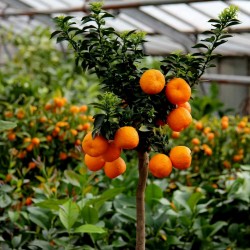
CHINOTTO - Myrtle Leaved...
Prijs
€ 6,00
(SKU: V 145)
Seeds Gallery EU,
5/
5
<h2><strong>CHINOTTO - Myrtle Leaved Orange Tree Seeds</strong></h2>
<h2><span style="color: #ff0000;"><strong>Price for Package of 3 seeds.</strong></span></h2>
<p>Citrus myrtifolia, the myrtle-leaved orange tree, is a species of Citrus with foliage similar to that of the common myrtle. It is a compact tree with small leaves and no thorns which grows to a height of three metres and can be found in Malta, Libya and in the Liguria, Tuscany, Sicily, and Calabria regions of Italy.</p>
<p>The fruit of the tree resemble small oranges. They are sour or bitter and are commonly called by their Italian name, chinotto. They are an essential flavoring agent of most Italian amari, of the popular Campari aperitif, and of several brands of carbonated soft drinks that are generically called "chinotto".</p>
<p><strong>Citrus myrtifolia is sometimes planted in gardens. Due to its compactness, it can also be planted in a pot or other container.</strong></p>
V 145


Plant bestand tegen kou en vorst
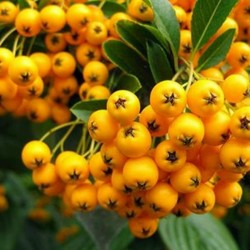
Scarlet Firethorn Seeds...
Prijs
€ 1,50
(SKU: T 19)
Seeds Gallery EU,
5/
5
<meta http-equiv="Content-Type" content="text/html; charset=UTF-8" />
<h2><span style="font-size: 14pt;"><strong>Scarlet Firethorn Seeds (Pyracantha coccinea) Hardy</strong></span></h2>
<h2><span style="font-size: 14pt;"><strong><span style="color: #ff0000;">Price for Package of 20 seeds.</span></strong></span></h2>
<div><span>Scarlet Firethorn is a large, fast growing, semi-evergreen to evergreen shrub that is cherished for its spectacular fall and winter display of scarlet fruits and ability to withstand difficult conditions. Shooting long limber stems in all directions, an untrained Firethorn, typically grows into a tangled mound up to 18 feet in height and 12 feet wide. It is armed with sharp thorns that hide among the dark, glossy green leaves. Abundant clusters (corymbs) of small white flowers appear in spring. The flower clusters are up to 2 inches across and are borne close together creating the appearance of nearly solid surface of flowers. In fall the 1/4 inch berries begin to ripen, their color mellowing from green to shades of red and orange. These persist through winter and into early spring depending on climate and appetite of the local bird population. The prolific flowers are lovely to behold and have some fragrance (although not all would agree that it is appealing). Birds, especially cedar waxwings, like the plump, colorful berries. The brilliant berry-laden branches of Firethorn hold up extremely well in cut arrangements and add interest and color to wreaths.</span></div>
<div>Firethorn is often used as an espalier. Held flat against a wall, it can be shaped quite creatively. Landscapers love the firethorns for their fast rate of growth and ability to withstand drought and neglect. The shrubs ruggedness and disease and pest resistance makes this plant a very popular item in commercial landscapes. The wide-reaching stems may be pruned back as needed during warm weather as the shrub blooms on old wood. Consider using it as a formal or informal hedge. This will require some trimming and shaping for the first few years but the effort will produce impressively beautiful and secure (thorny) hedges.</div>
<div>Leaf: Alternate, simple, oblong to lanceolate, serrated margin, 1 to 2 inches long, semi-evergreen to evergreen, shiny, dark green above, paler and pubescent below. </div>
<div>Flower: Creamy white, 5 petals, 1/3 inch across in tight clusters several inches across, appearing in late spring to early summer.</div>
<div>Fruit: Small pome, 1/4 inch across, bright orange-red, occurring in tight clusters, very showy, ripens in late summer and persists through the winter. </div>
<div>Twig: Slender, initially pubescent, later glaborous, red-brown, numerous spines, small buds. </div>
<div>Bark: Smooth reddish brown with numerous lenticels. </div>
<div>Form: Upright, open shrub with stiff limbs and thorns, can reach 18 feet tall. </div>
<div>Other Names: Scarlet Firethorn</div>
<div>Zone: 5 to 9 In moderate to severe zone 5 winters, the bronzed broadleaf evergreen foliage will severely "burn" or die, and stem dieback may occur anywhere from tip dieback all the way to the snowline.</div>
<div>Growth Rate: Fast to Moderate</div>
<div>Plant Type: Semi-evergreen to evergreen shrub</div>
<div>Family: Rosaceae</div>
<div>Native Range: Europe, Southwestern Asia</div>
<div>Height: 10 to 18 feet</div>
<div>Spread: 10 to 18 feet</div>
<div>Shape: Variable from upright and spreading to arching and irregular. Can become open without pruning.</div>
<div>Bloom Time: May</div>
<div>Bloom Color: White</div>
<div>Sun: Sun to Part Shade</div>
<div>Fall Color: Bronze to Evergreen</div>
<div>Drought Tolerance: Moderate to High (once established)</div>
<div>Water: Medium</div>
<div>Maintenance: Low to Moderate</div>
<div>Site Requirements/Soil Tolerances: Prefers moist, well-drained soils in full sun, but is very urban tolerant and adaptable to poor soils, compacted soils, soils of various pH, heat, drought, and heavy pruning. Will grow in partial to fairly heavy shade, however, flowering and fruiting will not be as heavy.</div>
<div>Culture: Difficult to prune because of thorns. Best time to prune vigorously growing specimens or espaliers is either right after bloom (to set up flower buds and fruits for the following year) or in autumn or early spring (to gain firm control with heavy pruning, and forego flowering and fruiting for an entire year).</div>
<div>Uses: Hedge/Screen, Espalier, Trellis, Bonsai, Crafts.</div>
<div>
<div>
<p>Hardy, Adaptable, Easy to Grow, Fast Growth, Attracts Birds, Wildlife Food/Shelter, Showy Flowers/Fruit, Hedge/Screen, Espalier, Trellis, Bonsai, Cold, Heat, Drought, Urban and Wind Tolerant</p>
</div>
</div>
<table>
<tbody>
<tr>
<td>
<p><span><strong>Sowing Instructions</strong></span></p>
</td>
</tr>
<tr>
<td nowrap="nowrap">
<p><span><strong>Propagation:</strong></span></p>
</td>
<td>
<p><span>Seeds</span></p>
</td>
</tr>
<tr>
<td nowrap="nowrap">
<p><span><strong>Pretreat:</strong></span></p>
</td>
<td>
<p><span>soak in water for 24 hours</span></p>
</td>
</tr>
<tr>
<td nowrap="nowrap">
<p><span><strong>Stratification:</strong></span></p>
</td>
<td>
<p><span>3-4 months in moist sowing mix at 2-5 ° C refrigerator</span></p>
</td>
</tr>
<tr>
<td nowrap="nowrap">
<p><span><strong>Sowing Time:</strong></span></p>
</td>
<td>
<p><span>all year round</span></p>
</td>
</tr>
<tr>
<td nowrap="nowrap">
<p><span><strong>Sowing Depth:</strong></span></p>
</td>
<td>
<p><span>3,2 mm - 1/8” (Cover lightly with substrate)</span></p>
</td>
</tr>
<tr>
<td nowrap="nowrap">
<p><span><strong>Sowing Mix:</strong></span></p>
</td>
<td>
<p><span>Coir or sowing mix + sand or perlite</span></p>
</td>
</tr>
<tr>
<td nowrap="nowrap">
<p><span><strong>Germination temperature:</strong></span></p>
</td>
<td>
<p><span>min. 18° C</span></p>
</td>
</tr>
<tr>
<td nowrap="nowrap">
<p><span><strong>Location:</strong></span></p>
</td>
<td>
<p><span>bright + keep constantly moist not wet</span></p>
</td>
</tr>
<tr>
<td nowrap="nowrap">
<p><span><strong>Germination Time:</strong></span></p>
</td>
<td>
<p><span>until it germinates </span></p>
</td>
</tr>
<tr>
<td nowrap="nowrap">
<p><span><strong>Watering:</strong></span></p>
</td>
<td>
<p><span>Water regularly during the growing season</span></p>
</td>
</tr>
<tr>
<td nowrap="nowrap">
<p><span><strong> </strong></span></p>
</td>
<td>
<p><br /><span><em>Copyright © 2012 Seeds Gallery - Saatgut Galerie - Galerija semena. </em><em>All Rights Reserved.</em></span></p>
</td>
</tr>
</tbody>
</table>
T 19 Y

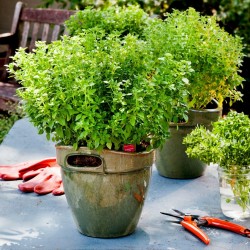
Bush or Greek Basil Seeds...
Prijs
€ 1,95
(SKU: MHS 26)
Seeds Gallery EU,
5/
5
<meta http-equiv="Content-Type" content="text/html; charset=UTF-8" />
<h2><strong>Bush or Greek Basil Seeds (Ocimum basilicum)</strong></h2>
<h2><span style="color: #ff0000;"><strong>Price for Package of 100 Seeds.</strong></span></h2>
<p><strong>Bush or Greek basil:<span> </span></strong>Has a strong aroma but mild flavor, so it can be substituted for sweet basil. Forms a compact bush with small leaves and grows well in a pot.</p>
<p><b>Basil</b><span> </span>(<span class="nowrap"><small>UK:<span> </span></small><span class="IPA nopopups noexcerpt">/<span><span title="/ˈ/: primary stress follows">ˈ</span><span title="'b' in 'buy'">b</span><span title="/æ/: 'a' in 'bad'">æ</span><span title="'z' in 'zoom'">z</span><span title="/əl/: 'le' in 'bottle'">əl</span></span>/</span></span>,<sup id="cite_ref-Collins_1-0" class="reference">[1]</sup><span> </span><span class="nowrap"><small>US:<span> </span></small><span class="IPA nopopups noexcerpt">/<span><span title="/ˈ/: primary stress follows">ˈ</span><span title="'b' in 'buy'">b</span><span title="/eɪ/: 'a' in 'face'">eɪ</span><span title="'z' in 'zoom'">z</span><span title="/əl/: 'le' in 'bottle'">əl</span></span>/</span></span>;<sup id="cite_ref-Collins2_2-0" class="reference">[2]</sup><span> </span><i>Ocimum basilicum</i>), also called<span> </span><b>great basil</b><span> </span>or<span> </span><b>Saint-Joseph's-wort</b>, is a<span> </span>culinary herb<span> </span>of the<span> </span>family<span> </span>Lamiaceae<span> </span>(mints).</p>
<p>Basil is native to tropical regions from central Africa to<span> </span>Southeast Asia.<sup id="cite_ref-simon_3-0" class="reference">[3]</sup><span> </span>It is a<span> </span>tender<span> </span>plant, and is used in<span> </span>cuisines<span> </span>worldwide. Depending on the species and cultivar, the leaves may taste somewhat like<span> </span>anise, with a strong, pungent, often sweet smell.</p>
<p>There are many<span> </span>varieties of basil, as well as several related species or hybrids also called basil. The type used commonly as a flavor is typically called<span> </span><b>sweet basil</b><span> </span>(or<span> </span><b>Genovese basil</b>), as opposed to<span> </span>Thai basil<span> </span>(<i>O. basilicum</i><span> </span>var.<span> </span><i>thyrsiflora</i>),<span> </span>lemon basil<span> </span>(<i>O. × citriodorum</i>), and<span> </span>holy basil<span> </span>(<i>Ocimum tenuiflorum</i>). While most common varieties of basil are treated as<span> </span>annuals, some are<span> </span>perennial<span> </span>in warm, tropical climates, including holy basil and a cultivar known as "African blue basil".</p>
<h2><span class="mw-headline" id="Description">Description</span></h2>
<p>Basil is an<span> </span>annual, or sometimes<span> </span>perennial, herb used for its leaves. Depending on the variety, plants can reach between 30 cm (0.98 ft) and 150 cm (4.9 ft). Its leaves are richly green and ovate, but otherwise come in a wide variety of sizes and shapes depending on cultivar. Leaf sizes range from 3 cm (1.2 in) to 11 cm (4.3 in) long, and between 1 cm (0.39 in) and 6 cm (2.4 in) wide. Basil grows a thick, central<span> </span>taproot. Its flowers are small and white, and grow from a central inflorescence that emerges from the central stem atop the plant.<sup class="noprint Inline-Template Template-Fact">[<i><span title="This claim needs references to reliable sources. (April 2019)">citation needed</span></i>]</sup></p>
<h3><span class="mw-headline" id="Phytochemistry">Phytochemistry</span></h3>
<p>The various basils have such different scents because the herb has a number of different<span> </span>essential oils<span> </span>in different proportions for various cultivars.<sup id="cite_ref-simon_3-1" class="reference">[3]</sup><span> </span>The essential oil from European basil contains high concentrations of<span> </span>linalool<span> </span>and<span> </span>methyl chavicol<span> </span>(estragole), in a ratio of about 3:1.<sup id="cite_ref-simon_3-2" class="reference">[3]</sup><sup id="cite_ref-janick_4-0" class="reference">[4]</sup><span> </span>Other constituents include:<span> </span>1,8-cineole,<span> </span>eugenol, and<span> </span>myrcene, among others.<sup id="cite_ref-simon_3-3" class="reference">[3]</sup><sup id="cite_ref-Breitmaier2006_5-0" class="reference">[5]</sup><span> </span>The<span> </span>clove<span> </span>scent of sweet basil is derived from<span> </span>eugenol.<sup id="cite_ref-Islam2011_6-0" class="reference">[6]</sup><span> </span>The aroma profile of basil includes<span> </span>1,8-cineole<sup id="cite_ref-suie_7-0" class="reference">[7]</sup><sup id="cite_ref-edsh_8-0" class="reference">[8]</sup><span> </span>and<span> </span>methyl eugenol.<sup id="cite_ref-suie_7-1" class="reference">[7]</sup><sup id="cite_ref-mobg_9-0" class="reference">[9]</sup></p>
<h2><span class="mw-headline" id="Taxonomy">Taxonomy</span></h2>
<div class="hatnote navigation-not-searchable">Further information:<span> </span>List of basil cultivars</div>
<p>The exact taxonomy of basil is uncertain due to the immense number of cultivars, its ready polymorphy, and frequent cross-pollination (resulting in new hybrids) with other members of the genus<span> </span><i>Ocimum</i><span> </span>and within the species.<span> </span><i>Ocimum basilicum</i><span> </span>has at least 60 varieties, which further complicates taxonomy.<sup id="cite_ref-simon_3-4" class="reference">[3]</sup></p>
<p>Most basils are cultivars of sweet basil.</p>
<ul>
<li>Anise basil,<span> </span>Licorice basil<span> </span>or<span> </span>Persian basil<span> </span>(<i>O. basilicum</i><span> </span>'Licorice')</li>
<li>Cinnamon basil<span> </span>(<i>Ocimum basilicum</i><span> </span>'Cinnamon')</li>
<li>Dark opal basil<span> </span>(<i>Ocimum basilicum</i><span> </span>'Dark Opal')</li>
<li>Lettuce leaf basil<span> </span>(<i>Ocimum basilicum</i><span> </span>'Crispum')</li>
<li>Purple basil (<i>Ocimum basilicum</i><span> </span>'Purpurescens')</li>
<li>Rubin basil<span> </span>(<i>Ocimum basilicum</i><span> </span>'Rubin')</li>
<li>Globe basil, dwarf basil, French basil (<i>Ocimum basilicum</i><span> </span>'Minimum'<sup id="cite_ref-10" class="reference">[10]</sup>)</li>
<li>Thai basil<span> </span>(<i>Ocimum basilicum thyrsifolium</i>)</li>
</ul>
<h3><span class="mw-headline" id="Hybrids">Hybrids</span></h3>
<ul>
<li>African blue basil<span> </span>(<i>Ocimum basilicum X O. kilimandscharicum</i>)</li>
<li>Spice basil (<i>Ocimum basilicum X O. americanum</i>), which is sometimes sold as holy basil)</li>
<li>Lemon basil<span> </span>(<i>Ocimum basilicum X O. americanum</i><sup id="cite_ref-11" class="reference">[11]</sup><sup id="cite_ref-12" class="reference">[12]</sup>)</li>
</ul>
<h3><span class="mw-headline" id="Similar_species">Similar species</span></h3>
<ul>
<li>Camphor basil, African basil (<i>O. kilimandscharicum</i>)</li>
<li>Clove basil, also African basil (<i>Ocimum gratissimum</i><sup id="cite_ref-tgte_13-0" class="reference">[13]</sup><sup id="cite_ref-aaeo_14-0" class="reference">[14]</sup>)</li>
<li>Holy basil<span> </span>(<i>Ocimum tenuiflorum</i>, formerly known as<span> </span><i>O. sanctum</i>)</li>
</ul>
<h3><span class="mw-headline" id="Other_cultivars">Other cultivars</span></h3>
<p>Several other basils, including some other<span> </span><i>Ocimum</i><span> </span>species, are grown in many regions of Asia. Most of the Asian basils have a<span> </span>clove-like flavor that is, in general, stronger than the Mediterranean basils. The most notable is the holy basil or<span> </span>tulsi, a revered home-grown plant in India and<span> </span>Nepal.</p>
<p>Lemon basil has a strong<span> </span>lemony<span> </span>smell and flavor very different from those of other varieties because it contains a chemical called<span> </span>citral. It is widely used in<span> </span>Indonesia, where it is called<span> </span><i>kemangi</i>, served raw together with raw<span> </span>cabbage,<span> </span>green beans, and<span> </span>cucumber<span> </span>as an accompaniment to fried fish or duck. Its flowers, when broken up, are a zesty<span> </span>saladcondiment.</p>
<h3><span class="mw-headline" id="Etymology">Etymology</span></h3>
<p>The name "basil" comes from Latin,<span> </span><i>basilius</i>, and Greek βασιλικόν φυτόν (<i>basilikón phutón</i>), "royal/kingly plant", possibly because the plant was believed to have been used in production of royal perfumes.<sup id="cite_ref-eo_15-0" class="reference">[15]</sup><span> </span>The Latin name has been confused with<span> </span>basilisk, as it was supposed to be an<span> </span>antidote<span> </span>to the basilisk's venom.<sup id="cite_ref-eo_15-1" class="reference">[15]</sup></p>
<h2><span class="mw-headline" id="Distribution_and_habitat">Distribution and habitat</span></h2>
<p>Basil is native to India and other tropical regions stretching from Africa to Southeast Asia, but has now become globalized due to human cultivation.<sup id="cite_ref-simon_3-5" class="reference">[3]</sup></p>
<h2><span class="mw-headline" id="Cultivation">Cultivation</span></h2>
<p>Most culinary and ornamental basils are cultivars of the species<span> </span><i>Ocimum basilicum</i>, but other species are also grown and there are many hybrids between species. Traditionally a green plant, some varieties, such as 'Purple Delight' have leaves that appear purple. Basil grows between 30–130 cm (12–51 in) tall, with opposite, light green, silky<span> </span>leaves<span> </span>3–11 cm (1.2–4.3 in) long and 1–6 cm (0.39–2.36 in) broad. The flowers are small, white in color and arranged in a terminal<span> </span>spike. Unusual among Lamiaceae, the four<span> </span>stamens<span> </span>and the<span> </span>pistil<span> </span>are not pushed under the upper lip of the<span> </span>corolla, but lie over the inferior lip. After<span> </span>entomophilous<span> </span>pollination, the corolla falls off and four round<span> </span>achenes<span> </span>develop inside the bilabiate<span> </span>calyx.</p>
<p>Basil is sensitive to cold, with best growth in hot, dry conditions. It behaves as an annual if there is any chance of a frost. However, due to its popularity, basil is cultivated in many countries around the world. Production areas include countries in the Mediterranean area, those in the<span> </span>temperate zone, and others in<span> </span>subtropical<span> </span>climates.<sup id="cite_ref-16" class="reference">[16]</sup></p>
<p>In Northern Europe, Canada, the northern states of the U.S., and the South Island of New Zealand it will grow best if sown under glass in a<span> </span>peat<span> </span>pot, then planted out in late spring/early summer (when there is little chance of a frost). Additionally, it may be sown in soil once chance of frost is past. It fares best in well-drained, sunny exposure.</p>
<p>Although basil grows best outdoors, it can be grown indoors in a pot and, like most herbs, will do best on a sun-facing windowsill. It should be kept away from extremely cold drafts, and grows best in strong sunlight, therefore a<span> </span>greenhouse<span> </span>or<span> </span>row cover<span> </span>is ideal if available. It can, however, be grown even in a basement, under fluorescent lights.</p>
<p>If its leaves have wilted from lack of water, it will recover if watered thoroughly and placed in a sunny location. Yellow leaves towards the bottom of the plant are an indication that the plant has been stressed; usually this means that it needs less water, or less or more fertilizer.</p>
<p>In sunnier climates such as Southern Europe, the southern states of the U.S., the North Island of New Zealand, and Australia, basil will thrive when planted outside. It also thrives over the summertime in the central and northern United States, but dies out when temperatures reach freezing point. It will grow back the next year if allowed to go to seed. It will need regular watering, but not as much attention as is needed in other climates.</p>
<p>Basil can also be propagated reliably from cuttings with the stems of short cuttings suspended for two weeks or so in water until roots develop.</p>
<p>Once a stem produces flowers, foliage production stops on that stem, the stem becomes woody, and essential oil production declines. To prevent this, a basil-grower may pinch off any flower stems before they are fully mature. Because only the blooming stem is so affected, some stems can be pinched for leaf production, while others are left to bloom for decoration or seeds.</p>
<p>Once the plant is allowed to flower, it may produce seed pods containing small black seeds, which can be saved and planted the following year. Picking the leaves off the plant helps promote growth, largely because the plant responds by converting pairs of leaflets next to the topmost leaves into new stems.</p>
<p>Basil is popularly recommended as a<span> </span>companion plant<span> </span>to the<span> </span>tomato. Common claims are that basil may deter pests or improve tomato flavor. However, in double-blind taste tests, basil did not significantly affect the taste of tomatoes when planted adjacent to them.<sup id="cite_ref-18" class="reference"></sup></p>
<h3><span class="mw-headline" id="Diseases">Diseases</span></h3>
<p>Basil suffers from several plant pathogens that can ruin the crop and reduce<span> </span>yield.<span> </span>Fusarium wilt<span> </span>is a soil-borne fungal disease that will quickly kill younger basil plants.<span> </span>Seedlings<span> </span>may be killed by<span> </span><i>Pythium</i><span> </span>damping off. A common<span> </span>foliar<span> </span>disease of basil is<span> </span>gray mold<span> </span>caused by<span> </span><i>Botrytis cinerea</i>; it can cause infections post-harvest and is capable of killing the entire plant.<span> </span>Black spot<span> </span>can be seen on basil foliage and is caused by the<span> </span>fungigenus<span> </span><i>Colletotrichum</i>.<span> </span>Downy mildew<span> </span>caused by<span> </span><i>Peronospora belbahrii</i><span> </span>is a significant disease, as first reported in Italy in 2004.<sup id="cite_ref-19" class="reference">[19]</sup><span> </span>It was reported in the U.S. in 2007 and 2008.<sup id="cite_ref-21" class="reference"></sup></p>
<p>Non-pathogenic bacteria found on basil include<span> </span><i>Novosphingobium</i><span> </span>species.</p>
<h2><span class="mw-headline" id="Uses">Uses</span></h2>
<div class="thumb tleft">
<div class="thumbinner"><img alt="" src="https://upload.wikimedia.org/wikipedia/commons/thumb/7/72/Basilic-spice.jpg/200px-Basilic-spice.jpg" width="200" height="126" class="thumbimage" />
<div class="thumbcaption">
<div class="magnify"></div>
Dried basil leaves</div>
</div>
</div>
<h3><span class="mw-headline" id="Culinary">Culinary</span></h3>
<p>Basil is most commonly used fresh in recipes. In general, it is added at the last moment, as cooking quickly destroys the flavor. The fresh herb can be kept for a short time in plastic bags in the refrigerator, or for a longer period in the freezer, after being<span> </span>blanched<span> </span>quickly in boiling water. The dried herb also loses most of its flavor, and what little flavor remains tastes very different, with a weak<span> </span>coumarin<span> </span>flavor, like<span> </span>hay.<sup class="noprint Inline-Template Template-Fact">[<i><span title="This claim needs references to reliable sources. (July 2018)">citation needed</span></i>]</sup></p>
<p>Basil is one of the main ingredients in<span> </span>pesto—a green Italian oil-and-herb sauce.</p>
<p>The most commonly used Mediterranean basil<span> </span>cultivars<span> </span>are "Genovese", "Purple Ruffles", "Mammoth", "Cinnamon", "Lemon", "Globe", and "African Blue". The<span> </span>Chinese<span> </span>also use fresh or dried basils in soups and other foods. In<span> </span>Taiwan, people add fresh basil leaves to thick soups. They also eat<span> </span>fried chicken<span> </span>with deep-fried basil leaves. Basil (most commonly Thai basil) is commonly steeped in cream or milk to create an interesting flavor in ice cream or chocolates (such as truffles). The leaves are not the only part of basil used in culinary applications, the flower buds have a more subtle flavor and they are edible.</p>
<h4><span class="mw-headline" id="Seeds">Seeds</span></h4>
<p>When soaked in water, the seeds of several basil varieties become gelatinous, and are used in Asian drinks and desserts such as<span> </span><i>faluda</i>,<span> </span><i>sharbat-e-rihan</i>, or<span> </span><i>hột é</i>.</p>
<p>Research studies of the essential oil showed antifungal and insect-repelling properties,<sup id="cite_ref-apia_23-0" class="reference">[23]</sup><span> </span>including potential toxicity to<span> </span>mosquitos.<sup id="cite_ref-etdp_24-0" class="reference">[24]</sup></p>
<h3><span class="mw-headline" id="Folk_medicine">Folk medicine</span></h3>
<p>In<span> </span>folk medicine<span> </span>practices, such as those of<span> </span>Ayurveda<span> </span>or<span> </span>traditional Chinese medicine, basil is thought to have therapeutic properties.<sup id="cite_ref-25" class="reference">[25]</sup><sup id="cite_ref-:1_26-0" class="reference">[26]</sup></p>
<h2><span class="mw-headline" id="Culture">Culture</span></h2>
<p>There are many rituals and beliefs associated with basil. The French sometimes call basil "<i>l'herbe royale</i>" ("royal herb"),<sup id="cite_ref-CarrollVona2006_27-0" class="reference">[27]</sup><span> </span>while Jewish folklore suggests it adds strength while fasting.<sup id="cite_ref-Navarra2004_28-0" class="reference">[28]</sup><span> </span>In<span> </span>Portugal, dwarf bush basil is traditionally presented in a pot, together with a poem and a paper<span> </span>carnation, to a sweetheart, on the religious holidays of Saint John and Saint Anthony. However, basil represented hatred in ancient<span> </span>Greece, and European lore sometimes claims that basil is a symbol of<span> </span>Satan.<sup id="cite_ref-Arrowsmith2009_29-0" class="reference">[29]</sup></p>
<p>Holy basil, also called<span> </span>tulsi, is highly revered in<span> </span>Hinduism.</p>
<p>Basil has religious significance in the<span> </span>Greek Orthodox Church, where it is used to sprinkle holy water.<sup id="cite_ref-blessing-of-the-waters_30-0" class="reference">[30]</sup><span> </span>The<span> </span>Bulgarian Orthodox Church,<span> </span>Serbian Orthodox Church,<span> </span>Macedonian Orthodox Church<span> </span>and<span> </span>Romanian Orthodox Church<span> </span>use basil (Bulgarian and Macedonian:<span> </span><i>босилек</i>;<span> </span>Romanian:<span> </span><i>busuioc</i>,<span> </span>Serbian:<span> </span><span lang="sr" xml:lang="sr">босиљак</span>) to prepare holy water and pots of basil are often placed below church altars.<sup id="cite_ref-MacDermott1998_31-0" class="reference">[31]</sup></p>
<p>In Europe, basil is placed in the hands of the dead to ensure a safe journey.<sup id="cite_ref-CEPC2007_32-0" class="reference">[32]</sup><span> </span>In India, they place it in the mouth of the dying to ensure they reach God.<sup id="cite_ref-Bregman2010_33-0" class="reference">[33]</sup><span> </span>The ancient Egyptians and ancient Greeks believed it would open the gates of heaven for a person passing on.<sup id="cite_ref-Nelson-Shellenbarger2013_34-0" class="reference">[34]</sup></p>
<table cellspacing="0" cellpadding="0" border="1">
<tbody>
<tr>
<td colspan="2" width="100%" valign="top">
<p><span style="color: #008000;"><strong>Sowing Instructions</strong></span></p>
</td>
</tr>
<tr>
<td valign="top" nowrap="nowrap">
<p><span style="color: #008000;"><strong>Propagation:</strong></span></p>
</td>
<td valign="top">
<p><span style="color: #008000;">Seeds</span></p>
</td>
</tr>
<tr>
<td valign="top" nowrap="nowrap">
<p><span style="color: #008000;"><strong>Pretreat:</strong></span></p>
</td>
<td valign="top">
<p><span style="color: #008000;">0</span></p>
</td>
</tr>
<tr>
<td valign="top" nowrap="nowrap">
<p><span style="color: #008000;"><strong>Stratification:</strong></span></p>
</td>
<td valign="top">
<p><span style="color: #008000;">0</span></p>
</td>
</tr>
<tr>
<td valign="top" nowrap="nowrap">
<p><span style="color: #008000;"><strong>Sowing Time:</strong></span></p>
</td>
<td valign="top">
<p><span style="color: #008000;">all year round</span></p>
</td>
</tr>
<tr>
<td valign="top" nowrap="nowrap">
<p><span style="color: #008000;"><strong>Sowing Depth:</strong></span></p>
</td>
<td valign="top">
<p><span style="color: #008000;">Needs Light to germinate! Just sprinkle on the surface of the substrate + gently press</span></p>
</td>
</tr>
<tr>
<td valign="top" nowrap="nowrap">
<p><span style="color: #008000;"><strong>Sowing Mix:</strong></span></p>
</td>
<td valign="top">
<p><span style="color: #008000;">Coir or sowing mix + sand or perlite</span></p>
</td>
</tr>
<tr>
<td valign="top" nowrap="nowrap">
<p><span style="color: #008000;"><strong>Germination temperature:</strong></span></p>
</td>
<td valign="top">
<p><span style="color: #008000;">18-20 ° C</span></p>
</td>
</tr>
<tr>
<td valign="top" nowrap="nowrap">
<p><span style="color: #008000;"><strong>Location:</strong></span></p>
</td>
<td valign="top">
<p><span style="color: #008000;">bright + keep constantly moist not wet</span></p>
</td>
</tr>
<tr>
<td valign="top" nowrap="nowrap">
<p><span style="color: #008000;"><strong>Germination Time:</strong></span></p>
</td>
<td valign="top">
<p><span style="color: #008000;">1-2 weeks</span></p>
</td>
</tr>
<tr>
<td valign="top" nowrap="nowrap">
<p><span style="color: #008000;"><strong>Watering:</strong></span></p>
</td>
<td valign="top">
<p><span style="color: #008000;">Water regularly during the growing season</span></p>
</td>
</tr>
<tr>
<td valign="top" nowrap="nowrap">
<p><span style="color: #008000;"><strong> </strong></span></p>
</td>
<td valign="top">
<p><br /><span style="color: #008000;"><em>Copyright © 2012 Seeds Gallery - Saatgut Galerie - Galerija semena. </em><em>All Rights Reserved.</em></span></p>
</td>
</tr>
</tbody>
</table>
MHS 26 (100 S)

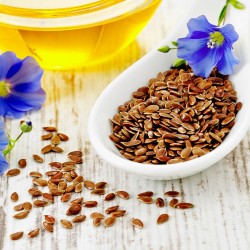
Common Flax Seeds (Linum...
Prijs
€ 1,35
(SKU: VE 215)
Seeds Gallery EU,
5/
5
<div id="idTab1" class="rte">
<h2><strong>Common Flax Seeds (Linum usitatissimum)</strong></h2>
<h2><span style="color: #ff0000;" class=""><strong>Price for Package of 120 (1g) seeds.</strong></span></h2>
<p>Flax (also known as common flax or linseed), with the binomial name Linum usitatissimum, is a member of the genus Linum in the family Linaceae. It is a food and fiber crop that is grown in cooler regions of the world. In addition to referring to the plant itself, the word "flax" may refer to the unspun fibers of the flax plant. The plant species is known only as a cultivated plant, and appears to have been domesticated just once from the wild species Linum bienne, called pale flax.</p>
<p><strong>Description</strong></p>
<p>Several other species in the genus Linum are similar in appearance to Linum usitatissimum, cultivated flax, including some that have similar blue flowers, and others with white, yellow, or red flowers. Some of these are perennial plants, unlike L. usitatissimum, which is an annual plant.</p>
<p>Cultivated flax plants grow to 1.2 m (3 ft 11 in) tall, with slender stems. The leaves are glaucous green, slender lanceolate, 20–40 mm long and 3 mm broad.</p>
<p>The flowers are pure pale blue, 15–25 mm diameter, with five petals. The fruit is a round, dry capsule 5–9 mm diameter, containing several glossy brown seeds shaped like an apple pip, 4–7 mm long.</p>
<p><strong>Uses</strong></p>
<p>Flax is grown for its oil, used as a nutritional supplement, and as an ingredient in many wood-finishing products. Flax is also grown as an ornamental plant in gardens. Flax fibers are used to make linen. The Latin species name usitatissimum means most useful.</p>
<p>Flax fibres are taken from the stem of the plant and are two to three times as strong as those of cotton. As well, flax fibers are naturally smooth and straight. Europe and North America depended on flax for vegetable-based cloth until the nineteenth century, when cotton overtook flax as the most common plant used for making rag-based paper. Flax is grown on the Canadian Prairies for linseed oil, which is used as a drying oil in paints and varnish and in products such as linoleum and printing inks.</p>
<p><strong>History</strong></p>
<p>The earliest evidence of humans using wild flax as a textile comes from the present day Republic of Georgia, where spun, dyed, and knotted wild flax fibers were found in Dzudzuana Cave and dated to the Upper Paleolithic, 30,000 years ago. Flax was first domesticated in the Fertile Crescent region. There is evidence of a domesticated oil-seed flax with increased seed size by 9,000 years ago from Tell Ramad in Syria. Use of the crop steadily spread, reaching places as far as Switzerland and Germany by 5,000 years ago (3,000 BCE). In China and India domesticated flax was cultivated by at least 5,000 years ago (3,000 BCE).</p>
<p>Flax was extensively cultivated in ancient Egypt, where temple walls had paintings of flowering flax and mummies were entombed in linen. Egyptian priests only wore linen, as flax was considered a symbol of purity. Phoenicians traded Egyptian linen throughout the Mediterranean, and the Romans used it for their sails. As the Roman Empire declined, so did flax production, but Charlemagne revived the crop in the 8th century CE with laws designed to publicize the hygiene of linen textiles and the health of linseed oil. Eventually, Flanders became the major center of the linen industry in the European Middle Ages. In North America, flax was introduced by the colonists and it flourished there. But by the early 20th century cheap cotton and rising farm wages had caused production of flax to become concentrated in northern Russia, which came to provide 90% of the world's output. Since then flax has lost its importance as a commercial crop, due to the easy availability of more durable fibers.</p>
<p><strong>Flax seeds</strong></p>
<p>Flax seeds come in two basic varieties: 1. brown; and 2. yellow or golden (also known as golden linseeds). Most types have similar nutritional characteristics and equal numbers of short-chain omega-3 fatty acids. The exception is a type of yellow flax called solin (trade name Linola), which has a completely different oil profile and is very low in omega-3 FAs. Flax seeds produce a vegetable oil known as flaxseed oil or linseed oil, which is one of the oldest commercial oils. It is an edible oil obtained by expeller pressing, sometimes followed by solvent extraction. Solvent-processed flax seed oil has been used for many centuries as a drying oil in painting and varnishing.</p>
<p>Although brown flax can be consumed as readily as yellow, and has been for thousands of years, its better-known uses are in paints, for fiber, and for cattle feed.</p>
<p><strong>Culinary</strong></p>
<p>One hundred grams of ground flax seed supplies about 450 calories, 41 grams of fat, 28 grams of fiber, and 20 grams of protein.</p>
<p>Flax seed sprouts are edible, with a slightly spicy flavor. Excessive consumption of flax seeds with inadequate water can cause bowel obstruction. In northern India, flaxseed, called (tisi or alsi), is traditionally roasted, powdered, and eaten with boiled rice, a little water, and a little salt.</p>
<p>Whole flax seeds are chemically stable, but ground flaxseed can go rancid at room temperature in as little as one week, although there is contrary evidence. Refrigeration and storage in sealed containers will keep ground flax from becoming rancid for a longer period; under conditions similar to those found in commercial bakeries, trained sensory panelists could not detect differences between bread made with freshly ground flax and bread made with milled flax stored for four months at room temperature. Milled flax is stable to oxidation when stored for nine months at room temperature if packed immediately without exposure to air and light and for 20 months at ambient temperatures under warehouse conditions.</p>
<p>Three natural phenolic glucosides, secoisolariciresinol diglucoside, p-coumaric acid glucoside and ferulic acid glucoside, can be found in commercial breads containing flaxseed.</p>
<p><strong>Medicinal</strong></p>
<p>Linum usitatissimum seeds are mentioned in the Ayurveda and have been used in the traditional Austrian medicine internally (directly soaked or as tea) and externally (as compresses or oil extracts) for treatment of disorders of the respiratory tract, eyes, infections, cold, flu, fever, rheumatism and gout.</p>
<p><strong>Nutrients and clinical research</strong></p>
<p>Flax seeds contain high levels of dietary fiber as well as lignans, an abundance of micronutrients and omega-3 fatty acids (table). Studies have shown that flax seeds may lower cholesterol levels, although with differing results depending on the sex of the consumer. One study found results were better for women whereas a later study found benefits only for men. Initial studies suggest that flax seeds taken in the diet may benefit individuals with certain types of breast and prostate cancers.</p>
<p>A study done at Duke University suggests that flaxseed may stunt the growth of prostate tumors, although a meta-analysis found the evidence on this point to be inconclusive. Flax may also lessen the severity of diabetes by stabilizing blood-sugar levels. There is some support for the use of flax seed as a laxative due to its dietary fiber content though excessive consumption without liquid can result in intestinal blockage. Consuming large amounts of flax seed may impair the effectiveness of certain oral medications, due to its fiber content,. Flaxseed has shown to lower the concentration of pro-inflammatory oxylipins in humans as well as lower blood pressure in patients with peripheral arterial disease and high blood pressure.</p>
<p>Flax seeds contain 23% 18:3 Omega-3 fatty acids (mostly ALA) and 6% 18:2 Omega-6 fatty acids. Flaxseed oil contains 53% 18:3 Omega-3 fatty acids (mostly ALA) and 13% 18:2 Omega-6 fatty acids.</p>
<p>One of the main components of flax is lignan, which has plant estrogen as well as antioxidants (flax contains up to 800 times more lignans than other plant foods contain).</p>
<p><strong>Toxicity</strong></p>
<p>Flaxseed oil has repeatedly been demonstrated to be non-toxic and is generally recognized as safe for human consumption. The cyanogenic glycoside linamarin occurs at low levels in the seed and cannot be detected in flaxseed oil. Cyanogenic glycosides are common food substances and are particularly toxic when consumed in larger quantities in staple foods like cassava. Flaxseed is not a staple food and the cyanogenic glycosides do not present a feasible risk in flaxseed product consumption.</p>
<p><strong>Flax fibers</strong></p>
<p>Flax fiber is extracted from the bast or skin of the stem of the flax plant. Flax fiber is soft, lustrous and flexible; bundles of fiber have the appearance of blonde hair, hence the description "flaxen". It is stronger than cotton fiber but less elastic. The best grades are used for linen fabrics such as damasks, lace and sheeting. Coarser grades are used for the manufacturing of twine and rope, and historically for canvas and webbing equipment. Flax fiber is a raw material used in the high-quality paper industry for the use of printed banknotes and rolling paper for cigarettes and tea bags. Flax mills for spinning flaxen yarn were invented by John Kendrew and Thomas Porthouse of Darlington in 1787. New methods of processing flax and the rising price of cotton have led to renewed interest in the use of flax as an industrial fiber.</p>
<p><strong>Cultivation</strong></p>
<p>The soils most suitable for flax, besides the alluvial kind, are deep loams, and containing a large proportion of organic matter. Flax is often found growing just above the waterline in cranberry bogs. Heavy clays are unsuitable, as are soils of a gravelly or dry sandy nature. Farming flax requires few fertilizers or pesticides. Within eight weeks of sowing, the plant will reach 10–15 cm in height and will grow several centimeters per day under its optimal growth conditions, reaching 70–80 cm within fifteen days.</p>
<p><strong><em>Harvesting</em></strong></p>
<p><strong>Maturation</strong></p>
<p>Flax is harvested for fiber production after approximately 100 days, or a month after the plant flowers and two weeks after the seed capsules form. The base of the plant will begin to turn yellow. If the plant is still green, the seed will not be useful, and the fiber will be underdeveloped. The fiber degrades once the plant is brown.</p>
<p><strong>Methods</strong></p>
<p>There are two ways to harvest flax, one involving mechanized equipment (combines), and a second method, more manual and targeted towards maximizing the fiber length.</p>
<p><strong>Mechanical</strong></p>
<p>The mature plant is cut with mowing equipment, similar to hay harvesting, and raked into windrows. When dried sufficiently, a combine then harvests the seeds similar to wheat or oat harvesting. The amount of weeds in the straw affects its marketability, and this coupled with market prices determined whether the farmer chose to harvest the flax straw. If the flax was not harvested, it was typically burned, since the straw stalk is quite tough and decomposes slowly (i.e., not in a single season), and still being somewhat in a windrow from the harvesting process, the straw would often clog up tillage and planting equipment. It was common, in the flax growing regions of western Minnesota, to see the harvested flax straw (square) bale stacks start appearing every July, the size of some stacks being estimated at 10-15 yards wide by 50 or more yards long, and as tall as a two-story house</p>
<p><strong>Manual</strong></p>
<p>The mature plant is pulled up with the roots (not cut), so as to maximize the fiber length. After this, the flax is allowed to dry, the seeds are removed, and is then retted. Dependent upon climatic conditions, characteristics of the sown flax and fields, the flax remains on the ground between two weeks and two months for retting. As a result of alternating rain and the sun, an enzymatic action degrades the pectins which bind fibers to the straw. The farmers turn over the straw during retting to evenly rett the stalks. When the straw is retted and sufficiently dry, it is rolled up. It will then be stored by farmers before scutching to extract fibers.</p>
<p>Flax grown for seed is allowed to mature until the seed capsules are yellow and just starting to split; it is then harvested by combine harvester and dried to extract the seed.</p>
<p><strong>Threshing flax</strong></p>
<p>Threshing is the process of removing the seeds from the rest of the plant. As noted above in the Mechanical section, the threshing could be done in the field by a machine, or in another process, a description of which follows:</p>
<p>The process is divided into two parts: the first part is intended for the farmer, or flax-grower, to bring the flax into a fit state for general or common purposes. This is performed by three machines: one for threshing out the seed, one for breaking and separating the straw (stem) from the fiber, and one for further separating the broken straw and matter from the fiber. In some cases the farmers thrash out the seed in their own mill and therefore, in such cases, the first machine will be unnecessary.</p>
<p>The second part of the process is intended for the manufacturer to bring the flax into a state for the very finest purposes, such as lace, cambric, damask, and very fine linen. This second part is performed by the refining machine only.</p>
<p>The threshing process would be conducted as follows:</p>
<p> Take the flax in small bundles, as it comes from the field or stack, and holding it in the left hand, put the seed end between the threshing machine and the bed or block against which the machine is to strike; then take the handle of the machine in the right hand, and move the machine backward and forward, to strike on the flax, until the seed is all threshed out.</p>
<p> Take the flax in small handfuls in the left hand, spread it flat between the third and little finger, with the seed end downwards, and the root-end above, as near the hand as possible.</p>
<p> Put the handful between the beater of the breaking machine, and beat it gently till the three or four inches, which have been under the operation of the machine, appear to be soft.</p>
<p> Remove the flax a little higher in the hand, so as to let the soft part of the flax rest upon the little finger, and continue to beat it till all is soft, and the wood is separated from the fiber, keeping the left hand close to the block and the flax as flat upon the block as possible.</p>
<p> The other end of the flax is then to be turned, and the end which has been beaten is to be wrapped round the little finger, the root end flat, and beaten in the machine till the wood is separated, exactly in the same way as the other end was beaten.</p>
</div><script src="//cdn.public.n1ed.com/G3OMDFLT/widgets.js"></script>
VE 215 (1g)





